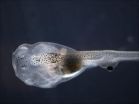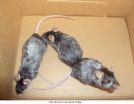(Press-News.org) The presence of an animal can significantly increase positive social behaviors in children with autism spectrum disorders (ASD), according to research published February 20 in the open access journal PLOS ONE by Marguerite E O'Haire and colleagues from the University of Queensland, Australia.
The authors compared how 5-13 year old children with ASD interacted with adults and typically-developing peers in the presence of two guinea pigs compared to toys. They found that in the presence of animals, children with ASD demonstrated more social behaviors like talking, looking at faces and making physical contact. They were also more receptive to social advances from their peers in the presence of the animals than they were when playing with toys. The presence of animals also increased instances of smiling and laughing, and reduced frowning, whining and crying behaviors in children with ASD more than having toys did.
Previous studies have shown that people are more likely to receive overtures of friendship from strangers when walking a dog than when walking alone, and similar effects have been observed for people holding smaller animals like rabbits or turtles. The authors suggest that this 'social lubricant' effect of animals on human social interactions can be particularly important for individuals with socio-emotional disabilities.
According to the authors, the ability of an animal to help children with ASD connect to adults may help foster interactions with therapists, teachers or other adult figures. They add that animal-assisted interventions may have applications in the classroom as well, saying "For children with ASD, the school classroom can be a stressful and overwhelming environment due to social challenges and peer victimization. If an animal can reduce this stress or artificially change children's perception of the classroom and its occupants, then a child with ASD may feel more at ease and open to social approach behaviors."
INFORMATION:
Citation: O'Haire ME, McKenzie SJ, Beck AM, Slaughter V (2013) Social Behaviors Increase in Children with Autism in the Presence of Animals Compared to Toys. PLoS ONE 8(2): e57010. doi:10.1371/journal.pone.0057010
Financial Disclosure: This research was supported by funding from the Thomas Meloy Foundation and Grant Number R03HD070683 from the Eunice Kennedy Shriver National Institute of Child Health & Human Development. The content is solely the responsibility of the authors and does not necessarily represent the official views of the Eunice Kennedy Shriver National Institute of Child Health & Human Development or the National Institutes of Health. The funders had no role in study design, data collection and analysis, decision to publish, or preparation of the manuscript.
Competing Interest Statement: The authors have declared that no competing interests exist.
PLEASE LINK TO THE SCIENTIFIC ARTICLE IN ONLINE VERSIONS OF YOUR REPORT (URL goes live after the embargo ends): http://dx.plos.org/10.1371/journal.pone.0057010
Children with autism show increased positive social behaviors when animals are present
Social behaviors increase in children with autism in the presence of animals compared to toys
2013-02-28
ELSE PRESS RELEASES FROM THIS DATE:
Nut-cracking monkeys use shapes to strategize their use of tools
2013-02-28
VIDEO:
This video shows two episodes in which a bearded capuchin monkey places and strikes a nut with the Stop meridian marked with a black line or a black-hatched line, and...
Click here for more information.
Bearded capuchin monkeys deliberately place palm nuts in a stable position on a surface before trying to crack them open, revealing their capacity to use tactile information to improve tool use. The results are published February 27 in the open access journal PLOS ...
Ectopic eyes function without connection to brain
2013-02-28
MEDFORD/SOMERVILLE, Mass. (February 27, 2013) – For the first time, scientists have shown that transplanted eyes located far outside the head in a vertebrate animal model can confer vision without a direct neural connection to the brain.
Biologists at Tufts University School of Arts and Sciences used a frog model to shed new light – literally – on one of the major questions in regenerative medicine, bioengineering, and sensory augmentation research.
"One of the big challenges is to understand how the brain and body adapt to large changes in organization," says Douglas ...
Infusion of stem cells and specially generated T-cells from same donor improves leukemia survival
2013-02-28
SEATTLE – In a significant advance for harnessing the immune system to treat leukemias, researchers at Fred Hutchinson Cancer Research Center for the first time have successfully infused large numbers of donor T-cells specific for a key anti-leukemic antigen to prolong survival in high-risk and relapsed leukemia patients after stem cell transplantation. Both the stem cells for transplant and the T-cells came from the same matched donors.
Reporting results of a pilot clinical trial in the Feb. 27 issue of the journal Science Translational Medicine, researchers describe ...
Risk of heart attack death may increase after adult sibling's death
2013-02-28
Your risk of dying from a heart attack may increase after your adult sibling dies, according to new research in the Journal of the American Heart Association.
"Death of a family member is so stressful that the resulting coping responses could lead to a heart attack," said Mikael Rostila, Ph.D., lead author of the study and associate professor at Stockholm University/Karolinska Institutet in Stockholm, Sweden. "But our results suggest that this association between the loss of a sibling and having a heart attack is more likely to occur some years after bereavement."
The ...
Researchers look to breath to identify stress
2013-02-28
The perennial stress-buster – a deep breath – could become stress-detector, claims a team of researchers from the UK.
According to a new pilot study, published today, 28 February, in IOP Publishing's Journal of Breath Research, there are six markers in the breath that could be candidates for use as indicators of stress.
The researchers hope that findings such as these could lead to a quick, simple and non-invasive test for measuring stress; however, the study, which involved just 22 subjects, would need to be scaled-up to include more people, over a wider range of ...
Modified protein could become first effective treatment for vitiligo
2013-02-28
MAYWOOD, Il. – Loyola University Chicago Stritch School of Medicine researchers have developed a genetically modified protein that dramatically reverses the skin disorder vitiligo in mice, and has similar effects on immune responses in human skin tissue samples.
The modified protein is potentially the first effective treatment for vitiligo, which causes unsightly white patches on the face, hands and other parts of the body. Loyola University Chicago has submitted a patent application for the protein, and researchers are seeking regulatory approval and funding for a ...
Spinal cancer: Guidelines for diagnosis unsupported in patients with lower back pain
2013-02-28
A new systematic review published in The Cochrane Library has raised doubts as to the effectiveness of "red flag" indicators at both identifying and excluding cancer in patients with lower back pain. The authors of the review concluded that most individual red flags were poor at diagnosing spinal malignancies and call for further studies focused on combinations of red flags.
Lower back pain is a common complaint, often with no obvious cause. In around 1-5% of patients with lower back pain, the condition results from a more serious underlying problem, such as a tumour. ...
Screening decisions are better informed when risk information is personalized
2013-02-28
Patients' ability to make genuinely informed choices about undergoing disease screening increases when the risk information that they receive is related to their own personal risk, rather than average risks, according to the results of a Cochrane systematic review. The authors reviewed data from studies, largely on cancer screens, in which patients were provided with personalised risk estimates.
The benefits of screening are not clear-cut. For example, screening can help detect cancer early, leading to successful treatment, but it can also lead to unnecessary treatment ...
Housing improvements should be targeted at those in poorest health
2013-02-28
Improving housing can improve health, particularly when interventions are targeted at those in the poorest health, according to a systematic review published in The Cochrane Library. The authors say their review underscores the importance of targeting those most in need when devising programmes for housing improvement.
Despite a wealth of research linking housing to health, it remains difficult to separate the effects of poor housing from the effects of other socioeconomic factors that influence health, such as poverty. The link could be made more strongly by showing ...
Patients with diabetes at no greater risk for infection
2013-02-28
Rosemont, Ill. – Patients with diabetes were no more likely to suffer infection, deep vein thrombosis (a deep vein blood clot) or other complications following total knee replacement (TKR) than patients without diabetes, according to new research published online today, in advance of its publication in the March 2013 Journal of Bone and Joint Surgery (JBJS).
The study authors sought to determine whether or not blood sugar level (glycemic control) influenced outcome in TKR. Fifty-two percent of people with diabetes have arthritis. Previous studies have found that poor ...
LAST 30 PRESS RELEASES:
Study: Teens use cellphones for an hour a day at school
After more than two years of war, Palestinian children are hungry, denied education and “like the living dead”
The untold story of life with Prader-Willi syndrome - according to the siblings who live it
How the parasite that ‘gave up sex’ found more hosts – and why its victory won’t last
When is it time to jump? The boiling frog problem of AI use in physics education
Twitter data reveals partisan divide in understanding why pollen season's getting worse
AI is quick but risky for updating old software
Revolutionizing biosecurity: new multi-omics framework to transform invasive species management
From ancient herb to modern medicine: new review unveils the multi-targeted healing potential of Borago officinalis
Building a global scientific community: Biological Diversity Journal announces dual recruitment of Editorial Board and Youth Editorial Board members
Microbes that break down antibiotics help protect ecosystems under drug pollution
Smart biochar that remembers pollutants offers a new way to clean water and recycle biomass
Rice genes matter more than domestication in shaping plant microbiomes
Ticking time bomb: Some farmers report as many as 70 tick encounters over a 6-month period
Turning garden and crop waste into plastics
Scientists discover ‘platypus galaxies’ in the early universe
Seeing thyroid cancer in a new light: when AI meets label-free imaging in the operating room
Neutrophil-to-lymphocyte ratio may aid risk stratification in depressive disorder
2026 Seismological Society of America Annual Meeting
AI-powered ECG analysis offers promising path for early detection of chronic obstructive pulmonary disease, says Mount Sinai researchers
GIMM uncovers flaws in lab-grown heart cells and paves the way for improved treatments
Cracking the evolutionary code of sleep
Medications could help the aging brain cope with surgery, memory impairment
Back pain linked to worse sleep years later in men over 65, according to study
CDC urges ‘shared decision-making’ on some childhood vaccines; many unclear about what that means
New research finds that an ‘equal treatment’ approach to economic opportunity advertising can backfire
Researchers create shape-shifting, self-navigating microparticles
Science army mobilizes to map US soil microbiome
Researchers develop new tools to turn grain crops into biosensors
Do supervised consumption sites bring increased crime? Study suggests that’s a myth
[Press-News.org] Children with autism show increased positive social behaviors when animals are presentSocial behaviors increase in children with autism in the presence of animals compared to toys



